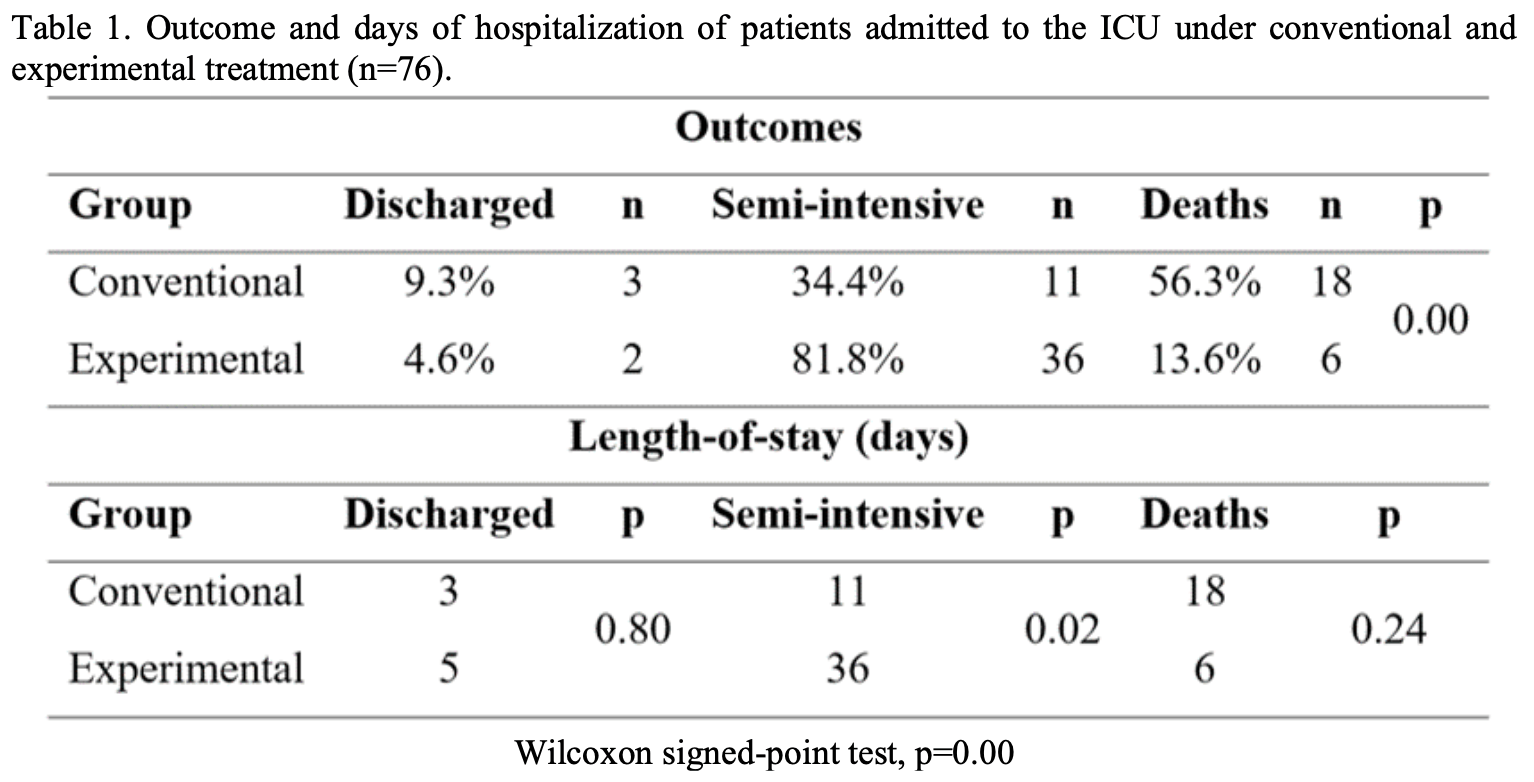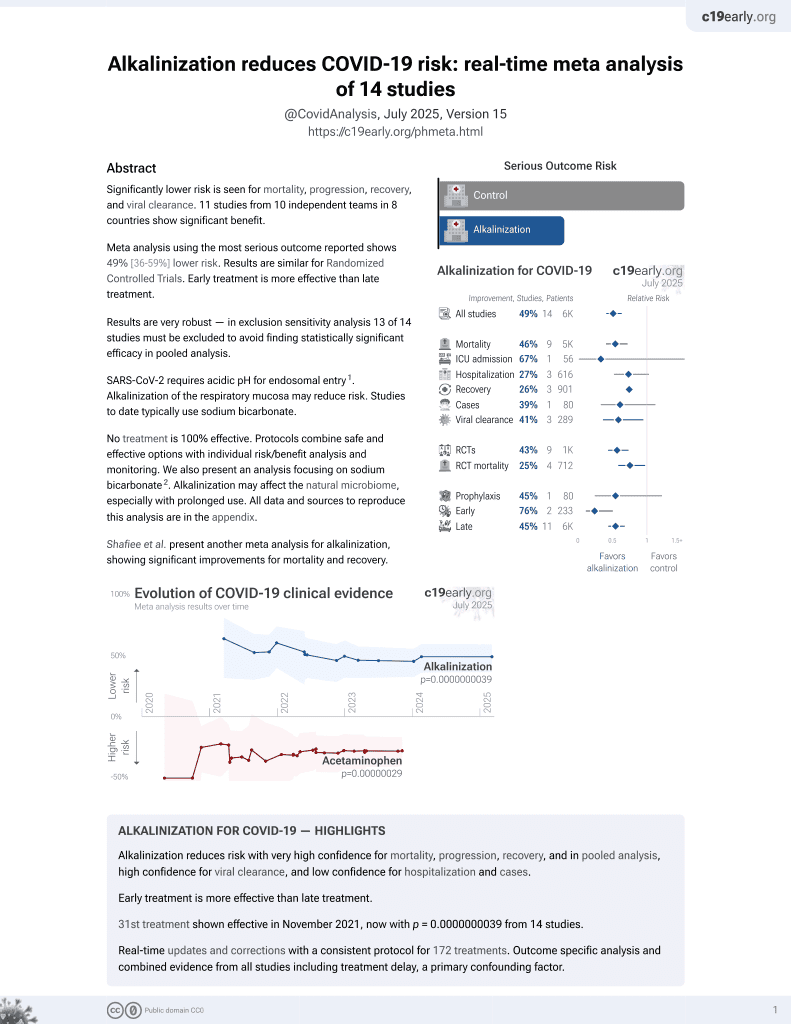
Preliminary observation of the use of sodium bicarbonate solution as an adjunct in the treatment of coronavirus 2019 disease (COVID-19): prognosis improvement in patients requiring intensive care
et al., Brazilian Journal of Development, doi:10.34117/bjdv7n12-039, Dec 2021
31st treatment shown to reduce risk in
November 2021, now with p = 0.0000000039 from 14 studies.
No treatment is 100% effective. Protocols
combine treatments.
6,300+ studies for
210+ treatments. c19early.org
|
Analysis of 76 ICU patients in Brazil, 44 treated with bronchoalveolar lavage using 3% sodium bicarbonate, showing significantly lower mortality with treatment.
Bronchoalveolar lavage with 10ml of sodium bicarbonate solution directly into the tube (closed circuit), 500μl for each lung segment, followed by aspiration of the solution, performed every 6 hours for 7 days.
|
risk of death, 75.8% lower, RR 0.24, p < 0.001, treatment 6 of 44 (13.6%), control 18 of 32 (56.2%), NNT 2.3.
|
| Effect extraction follows pre-specified rules prioritizing more serious outcomes. Submit updates |
Soares et al., 29 Dec 2021, prospective, Brazil, peer-reviewed, 17 authors, study period December 2020 - May 2021.
Preliminary observation of the use of sodium bicarbonate solution as an adjunct in the treatment of coronavirus 2019 disease (COVID-19): prognosis improvement in patients requiring intensive care / Observação preliminar do uso de solução de bicarbonato de sódio como coadjuvante no tratamento da doença coronavírus 2019 (COVID-19): melhora do prognóstico na necessidade de terapia intensiva
Brazilian Journal of Development, doi:10.34117/bjdv7n12-039
Introduction: This study aimed to evaluate the use of sodium bicarbonate solution as an adjunct in the treatment of critically ill patients in an intensive care unit (ICU). Methods: A group of 76 patients were followed up, of which 44 received treatment with a sodium bicarbonate (NaHCO3) solution along with the conventional treatment, and 32 patients used only the conventional treatment. Results: In patients treated, there was an improvement in radiological findings, a decrease in opacity and bilateral consolidations, as well as reduced length of stay in the ICU, and mortality. Conclusion: The use of NaHCO3 solution as an adjunct in the treatment of COVID-19 improved prognosis compared to conventional treatment.
References
Aslan, Kandiş, Akgun, Cakir, Inandi et al., The effect of nebulized NaHCO3 treatment on "RADS" due to chlorine gas inhalation, Brazilian Journal of Development
Belouzard, Millet, Licitra, Whittaker, Mechanisms of coronavirus cell entry mediated by the viral spike protein, Viruses
Bhatnagar, Ali, Lewis, Johnson, Correlation of chest radiography findings with the severity and progression of COVID-19 pneumonia, Clin Imaging
Choi, Hong, Kim, The association between mortality and the oxygen saturation and fraction of inhaled oxygen in patients requiring oxygen therapy due to COVID-19-Associated pneumonia, Tuberc Respir Dis
El-Badrawy, Arram, Abdalla, Effect of adding inhalation of sodium bicarbonate 8.4% to the usual treatment on smear-positive pulmonary tuberculosis: A prospective controlled study, Egypt J Bronchol
Farha, French, Stokes, Brown, Bicarbonate alters bacterial susceptibility to antibiotics by targeting the proton motive force, ACS Infect Dis
Gomez, Parazzi, Clinckspoor, Safety, tolerability and effectes of sodium bicarbonate inhalation in cystic fibrosis, Clin Drug Investig
Machado, Glaser, Araujo, Petiz, Oliveira et al., Inhibition of Severe Acute Respiratory Syndrome Coronavirus 2 Replication by Hypertonic Saline Solution in Lung and Kidney Epithelial Cells, ACS Pharmacol Transl Sci
Rossi, Morelli, Galietta, Colin, Airway microenvironment alterations and pathogen growth in cystic fibrosis, Pediatr Pneumol
Skehel, Bayley, Brown, Martin, Waterfield et al., Changes in the conformation of influenza virus hemagglutinin at the pH optimum of virusmediated membrane fusion, Proc Nati Acad Sci
Toussie, Voutsinas, Finkelstein, Cedillo, Manna et al., Clinical and chest radiography features determine patient outcomes in young and middle-aged adults with COVID-19, Radiology
Wardeh, Conklin, Ko, Case reports of observed significant improvement in patients with ARDS due to COVID-19 and maximum ventilatory support after inhalation of sodium bicarbonate, J Clin. Intensive Care Med
White, Chu, Mcelroy, Chu, Bauman et al., The avian coronavirus infectious bronchitis virus undergoes direct low-pH-dependent fusion activation during entry into host cells, Annu Rev Physiol
Wunsch, Mechanical ventilation in COVID-19: Interpreting the current epidemiology, Am J Respir Crit Care Med
DOI record:
{
"DOI": "10.34117/bjdv7n12-039",
"ISSN": [
"2525-8761"
],
"URL": "http://dx.doi.org/10.34117/bjdv7n12-039",
"abstract": "<jats:p>Introduction: This study aimed to evaluate the use of sodium bicarbonate solution as an adjunct in the treatment of critically ill patients in an intensive care unit (ICU). Methods: A group of 76 patients were followed up, of which 44 received treatment with a sodium bicarbonate (NaHCO3) solution along with the conventional treatment, and 32 patients used only the conventional treatment. Results: In patients treated, there was an improvement in radiological findings, a decrease in opacity and bilateral consolidations, as well as reduced length of stay in the ICU, and mortality. Conclusion: The use of NaHCO3 solution as an adjunct in the treatment of COVID-19 improved prognosis compared to conventional treatment. </jats:p>",
"author": [
{
"affiliation": [],
"family": "Soares",
"given": "Carolina Pontes",
"sequence": "first"
},
{
"affiliation": [],
"family": "Da Silva",
"given": "Simone Aparecida Fernandes",
"sequence": "additional"
},
{
"affiliation": [],
"family": "Soares",
"given": "Fernanda Farias",
"sequence": "additional"
},
{
"affiliation": [],
"family": "Monteiro",
"given": "Edna Lopes",
"sequence": "additional"
},
{
"affiliation": [],
"family": "De Souza",
"given": "Socorro Elizabeth Rodrigues",
"sequence": "additional"
},
{
"affiliation": [],
"family": "Brilhante",
"given": "Andréia Fernandes",
"sequence": "additional"
},
{
"affiliation": [],
"family": "Pereira",
"given": "Rita de Cássia Ribeiro",
"sequence": "additional"
},
{
"affiliation": [],
"family": "Costa",
"given": "Joicely Melo",
"sequence": "additional"
},
{
"affiliation": [],
"family": "Santos",
"given": "Leandro Cavalcante",
"sequence": "additional"
},
{
"affiliation": [],
"family": "De Moura",
"given": "Hemeson Lira",
"sequence": "additional"
},
{
"affiliation": [],
"family": "Lima",
"given": "Ildercílio Mota de Souza",
"sequence": "additional"
},
{
"affiliation": [],
"family": "Viana",
"given": "Larissa Vanessa Machado",
"sequence": "additional"
},
{
"affiliation": [],
"family": "Furtado",
"given": "Cydia de Menezes",
"sequence": "additional"
},
{
"affiliation": [],
"family": "Rodriguez",
"given": "Anselmo Fortunato Ruiz",
"sequence": "additional"
},
{
"affiliation": [],
"family": "Prado",
"given": "Patrícia Rezende",
"sequence": "additional"
},
{
"affiliation": [],
"family": "Lobato",
"given": "Cirley Maria de Oliveira",
"sequence": "additional"
},
{
"affiliation": [],
"family": "De Almeida",
"given": "Angélica Bento",
"sequence": "additional"
}
],
"container-title": "Brazilian Journal of Development",
"container-title-short": "BJDV",
"content-domain": {
"crossmark-restriction": false,
"domain": []
},
"created": {
"date-parts": [
[
2022,
1,
4
]
],
"date-time": "2022-01-04T21:07:16Z",
"timestamp": 1641330436000
},
"deposited": {
"date-parts": [
[
2022,
8,
13
]
],
"date-time": "2022-08-13T11:40:41Z",
"timestamp": 1660390841000
},
"indexed": {
"date-parts": [
[
2022,
8,
13
]
],
"date-time": "2022-08-13T12:11:01Z",
"timestamp": 1660392661429
},
"is-referenced-by-count": 0,
"issue": "12",
"issued": {
"date-parts": [
[
2021,
12,
29
]
]
},
"journal-issue": {
"issue": "12",
"published-online": {
"date-parts": [
[
2021,
12,
29
]
]
}
},
"link": [
{
"URL": "https://brazilianjournals.com/ojs/index.php/BRJD/article/download/40521/pdf",
"content-type": "application/pdf",
"content-version": "vor",
"intended-application": "text-mining"
},
{
"URL": "https://brazilianjournals.com/ojs/index.php/BRJD/article/download/40521/pdf",
"content-type": "unspecified",
"content-version": "vor",
"intended-application": "similarity-checking"
}
],
"member": "30764",
"original-title": [],
"page": "110698-110708",
"prefix": "10.34117",
"published": {
"date-parts": [
[
2021,
12,
29
]
]
},
"published-online": {
"date-parts": [
[
2021,
12,
29
]
]
},
"publisher": "South Florida Publishing LLC",
"reference-count": 0,
"references-count": 0,
"relation": {},
"resource": {
"primary": {
"URL": "https://brazilianjournals.com/ojs/index.php/BRJD/article/view/40521"
}
},
"score": 1,
"short-title": [],
"source": "Crossref",
"subject": [
"Anesthesiology and Pain Medicine"
],
"subtitle": [],
"title": "Preliminary observation of the use of sodium bicarbonate solution as an adjunct in the treatment of coronavirus 2019 disease (COVID-19): prognosis improvement in patients requiring intensive care / Observação preliminar do uso de solução de bicarbonato de sódio como coadjuvante no tratamento da doença coronavírus 2019 (COVID-19): melhora do prognóstico na necessidade de terapia intensiva",
"type": "journal-article",
"volume": "7"
}
